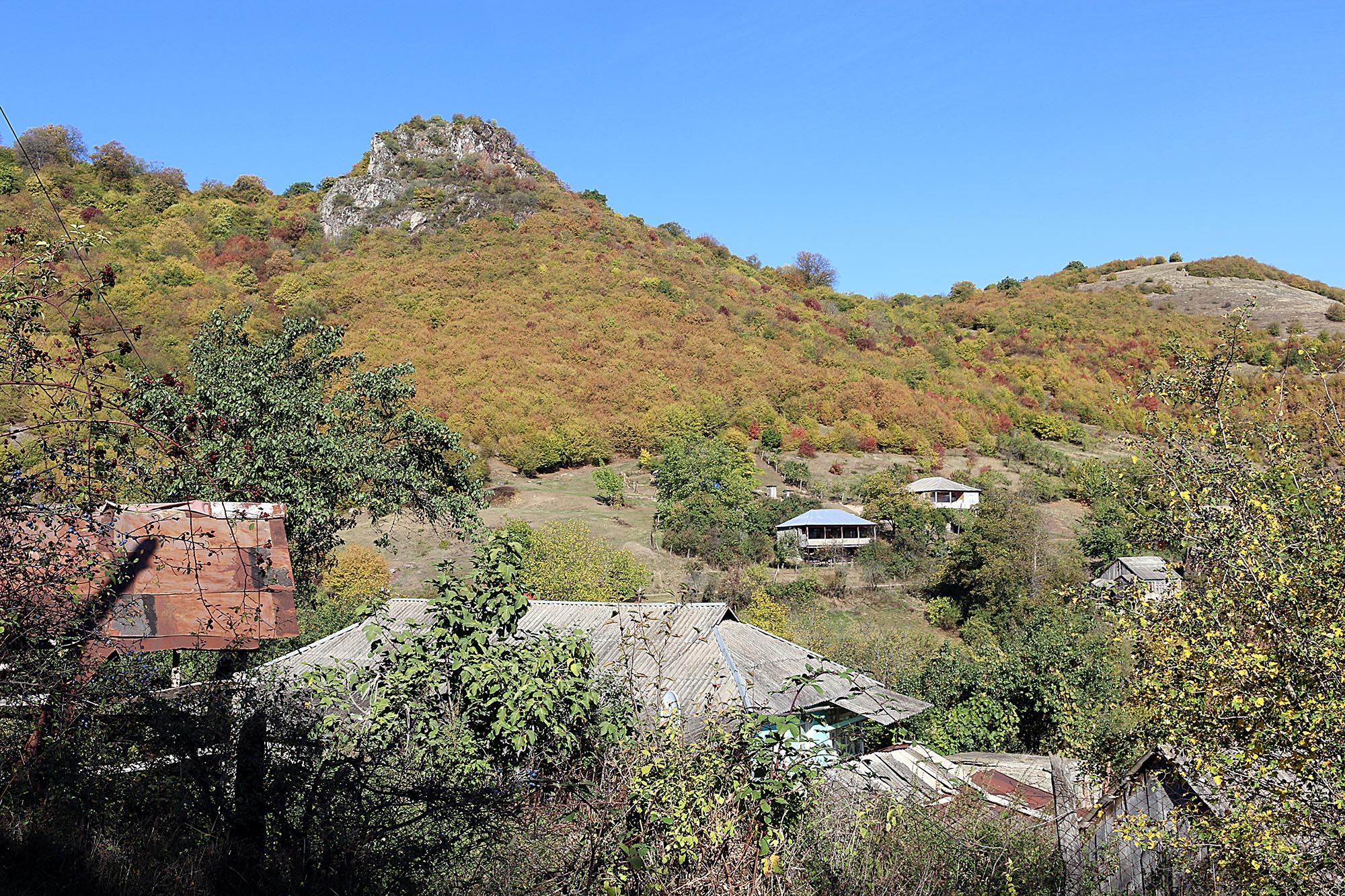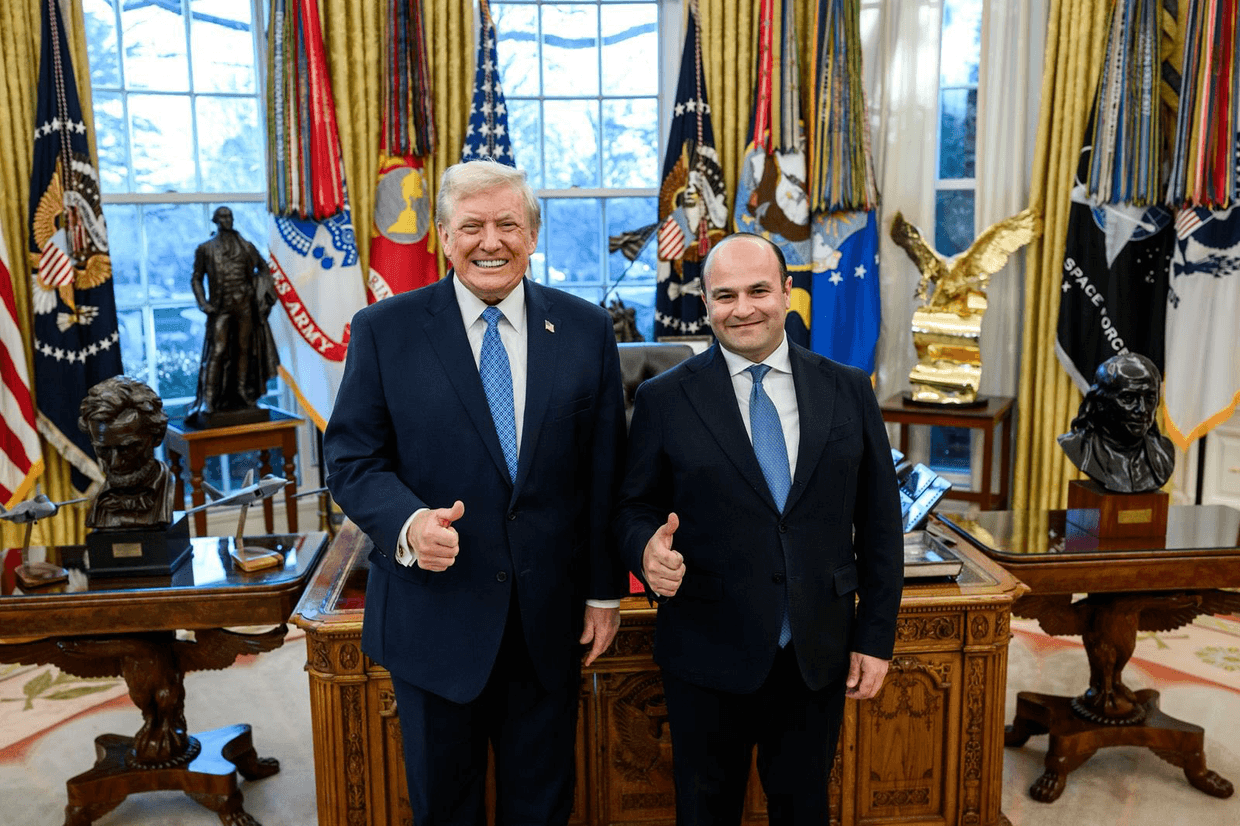
Khojorni is in Georgia, but the village is almost completely surrounded by Armenia. Residents struggle to access crucial forests, pastures, and even their water supply because of the border — even when what they seek is just a stone’s throw away.
‘Years ago I could bring raspberries and blackberries in buckets from the forest. I could even sell them’, Leyla Simonyan, a Khojorni resident, tells OC Media. ‘Almost everything we had was taken from there: firewood, pet food, even the water.’
The dense forest she refers to is just 70 metres from her home, but on the Armenian side of the border.
The tightening of the border between Armenia and Georgia has made life difficult for people in Khojorni. Located in Marneuli Municipality, in the south of Georgia, Khojorni borders Armenia on three sides.

Another resident of the village, Dmitri Kharibyan, says he has to tie his cows down when they go to pasture so they do not wander over into Armenia. Otherwise, he will have to follow them and face arrest for crossing the border illegally.
‘We live here as if its a colony’, he says, adding that he hopes that the two neighbouring countries will one day find a solution to make their lives easier.
Khojorni has a mixed Armenian-Azerbaijani population, a majority of whom are ethnically Armenian — 200 of the 240 families.

‘I have to be very careful with my cows’, Huseyn Abdurakhmanov tells OC Media. Abdurakhmanov, an Azerbaijani–Georgian, works as a teacher in the Azerbaijani sector of Khojorni’s public school.
He says he has never had problems with any of his fellow villagers.
‘I don’t want an Armenian-Georgian problem because of my cows’, he says, wary of the potential to cause an international incident because of wandering cattle.
He says that being located on the Armenian-Georgian border with a mixed Armenian-Azerbaijani population, the village is unique.


‘After the border regime is simplified, this village should become Georgia’s most unique and exemplary village for other border villages, and for countries that are in conflict as well’, he says.
The Armenian-Georgian border is about 225 kilometres long. An intergovernmental commission established in 1996 has been dealing with the delimitation and demarcation of the border.
Armenian Foreign Ministry spokesperson Anna Naghdalyan told OC Media that, at present, 147 kilometres of the border has been agreed upon through the commission. However, the border area which includes Khojorni, as well as the villages of Akhkorpi, Chanakhchi, and Brdadzor, is still under discussion.
As the negotiations are confidential, the foreign ministries of Armenia and Georgia have remained tight-lipped and have declined to say if there are any problematic areas.
‘There are a number of areas on which we still need to reach an agreement and, given the increasingly positive dynamics in our bilateral relations, we do hope that the issue will be resolved in line with the interests of both countries’, the Georgian Foreign Ministry told OC Media.
The ministry said that both sides were ready to work in a constructive way to reach a final agreement.
The house in two countries
‘Օur head is in Georgia and our feet are on the other side, in Armenia’, Mihran Simonyan tells OC Media, citing Toto and Fernandel from the film The Law Is the Law (1958), where the action takes place in the village of Assola, bisected by the French-Italian border.


For 92-year-old Makar Hakhverdyan, the metaphor is perhaps a little too apt.
Villagers advise us to visit Grandpa Makar, who they say, ‘really sleeps like this’. In 1970, Hakhverdyan built his house exactly on the edge of the village, right on the Armenian-Georgian border.
He told OC Media that he knew that the house’s location would technically place him in a different country than his neighbours, but at the time, both countries were within the USSR, and he didn’t believe it would ever become an issue.
‘When they [both countries’ representatives] came to measure the area, they said, “Your home is on the Armenian side, do you want to stay in Armenia or in Georgia?” I said “Georgia” because there was no straight road from here to Armenia’, Hakhverdyan said.
But while his house was now in Georgia, the toilet and most of the garden remained on the Armenian side. ‘Now, sometimes Armenian officials said, “you built a house in Georgia but your toilet is in Armenia, do you have the paper (a document for crossing the border) to go to your toilet?” I say the paper is in the toilet. What can I say?’

He said he does not have any problem with Armenian officials or border guards anymore.
Before the collapse of the USSR, Hakhverdyan worked as a forester for the Armenian SSR for 37 years, planting hundreds of trees in the forests of Armenia just above his home. He is no longer allowed to set foot in them. A small consolation, he says, is that he can still go to his orchard, which is also bisected by the border.
He makes spirits from the apples he picks in his Georgian-Armenian garden calling the beverage ‘a vodka of Armenian-Georgian friendship’.
He said that the final demarcation would hardly change anything for him, but he still wants to appeal to both countries’ authorities.
‘We are not criminals, we will not cross the forest, just let us move smoothly for the benefit of two friendly countries․’
Water from Armenia
Khojorni has been receiving water from the Armenian side of the border since the Soviet period․ Back then, local residents found a water source on a nearby mountain and connected it to a system of pipes that feed in to their homes.
Before the post-soviet border regime, villagers found it easy to fix any leaks or damaged pipes. But now, when the pipes are damaged or clogged, the villagers must go all the way around and cross into Armenia through the Sadakhlo-Bagratashen checkpoint, 13 kilometres away. They then have to take a route of at least 80 kilometres to reach the spring in the Armenian mountains.
Had the villagers been allowed to cross to the Armenian side from Khojorni, they would have to cross just 2-4 kilometres to reach the water source.
‘Last time, we raised money, sent it to Armenia, and the villager nearest to the border got it fixed’, local resident Alexander Suqiasyan told OC Media.
Residents report that sometimes it takes as long as a month before water access is restored after an interruption in service.


Arsen Hakhverdyan, a member of the Marneuli Municipal Council (sakrebulo) for Khojorni and neighbouring Berdadzor, Gulubagh, and Tsopi, told OC Media that the water problem would be resolved soon․
‘We have a source of water near the Armenian-Georgian border, but on Georgian territory’, Hakhverdyan said. He added that they hope to resolve the problem before the end of the year.
‘A border without border guards’
People in Khojorni say they want to stay in their village, which has a good climate for growing crops and breeding cattle, but under the current border regime, it is simply impossible.
The plots of land cultivated by the villagers are within the 500-metre restricted zone, that is under the control of the Georgian Ministry of Defence. As a result, they must present official documents to border guards each time they go to work on their land.

More difficult still is the fact that for those who rear cattle, the most grassy pastures are on the Armenian side of the border.
Alexander Suqiasyan told OC Media that despite difficulties, he still hopes that if the relationship between Georgia and Armenia improves, they could have a ‘border without border guards’.
‘We don’t want dividing lines between our two friendly countries’, he said.
Khojorni, as well as a number of other villages along the border, continue living with these restrictions.

Armenian Foreign Ministry spokesperson Anna Naghdalyan has said that there has been no joint meeting of the intergovernmental commission since 2007. However, she said the issue was being discussed during consultations between the Armenian-Georgian Intergovernmental Economic Commission and among the Foreign Ministries of the two countries, with the latest meeting held in May 2019 in Armenia.
Preparations for the next meeting is in progress.
In a statement to OC Media, the Georgian Foreign Ministry said that the delimitation of the state border was an extremely important issue.
‘We believe that in our case, the definition of the state border between our two friendly countries will not separate our nations but, vice-versa, will establish better links and create opportunities for trans-border cooperation. We also think that the final solution should be reached based on the interests of both sides.’








